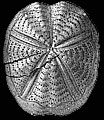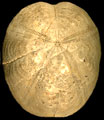The Echinoid Directory
Megapneustes Gauthier, in Fourtau 1899, p. 678
[=Fourtaunia Lambert, 1902, p. 53, type species Hypsospatangus santamariae Gauthier in Fourtau, 1900;=Thebaster Checchia-Rispoli, 1941, p. 6, type species Macropneustes fischeri de Loriol, 1880 ]
| Diagnostic Features |
|
|---|---|
| Distribution | Eocene, North Africa. |
| Name gender | feminine |
| Type | Megapneustes grandis Gauthier, 1899, p. 681, by original designation. Holotype: Museum National d\'Histoire Naturelle, Paris, J01701. |
| Species Included |
|
| Classification and/or Status |
|
| Remarks |
|




